The Team Group MP34 512GB SSD Review: Refining Phison's NVMe Workhorse
by Billy Tallis on May 15, 2019 9:00 AM EST- Posted in
- SSDs
- Storage
- Toshiba
- Phison
- M.2
- NVMe
- BiCS
- 3D TLC
- Team Group
- PS5012-E12
Random Read Performance
Our first test of random read performance uses very short bursts of operations issued one at a time with no queuing. The drives are given enough idle time between bursts to yield an overall duty cycle of 20%, so thermal throttling is impossible. Each burst consists of a total of 32MB of 4kB random reads, from a 16GB span of the disk. The total data read is 1GB.

The QD1 burst random read performance of the Team MP34 is higher than previous Phison E12 drives of any capacity, but it's a pretty small improvement. We haven't seen a higher score from any other 512GB-class drive, but that's probably because we have not yet tested a 512GB-class Silicon Motion SM2262EN drive with Micron NAND; that combination has a big lead among 1TB drives.
Our sustained random read performance is similar to the random read test from our 2015 test suite: queue depths from 1 to 32 are tested, and the average performance and power efficiency across QD1, QD2 and QD4 are reported as the primary scores. Each queue depth is tested for one minute or 32GB of data transferred, whichever is shorter. After each queue depth is tested, the drive is given up to one minute to cool off so that the higher queue depths are unlikely to be affected by accumulated heat build-up. The individual read operations are again 4kB, and cover a 64GB span of the drive.
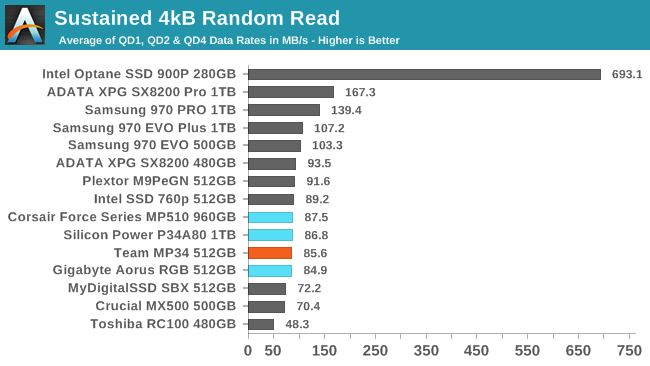
On the longer random read test, the Team MP34 and other Phison E12 drives fall even further behind the fastest TLC drives, but still have a clear performance advantage over the SATA entry-level NVMe drives.
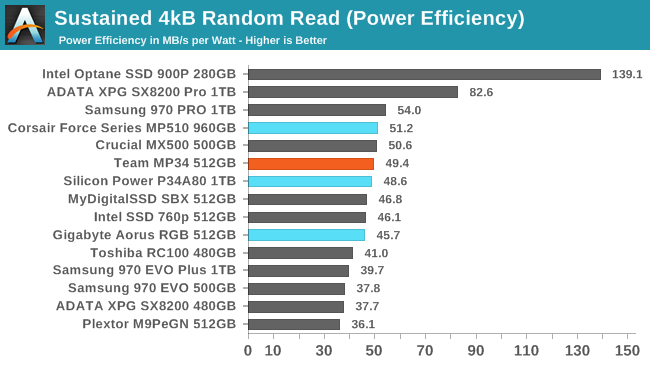 |
|||||||||
| Power Efficiency in MB/s/W | Average Power in W | ||||||||
The Team MP34 and other Phison E12 drives have good power efficiency on the random read test, comparable to the SATA drive and the better entry-level NVMe drives. But the Silicon Motion SM2262EN drives stand above the rest, requiring only a bit more power than the E12 and providing significantly better performance.
 |
|||||||||
At higher queue depths, the 512GB MP34 provides equal or better performance to the other drives of similar capacity that we have tested. Most of the 1TB drives are significantly faster at those queue depths, and it is likely that the ADATA SX8200 Pro's lead carries over to the smaller models that we have not had the opportunity to test.
At lower queue depths where the Team MP34 is still delivering performance within reach of SATA drives, its efficiency is nothing special—plenty of those SATA drives can perform the same while using much less power. Once the MP34's performance scales beyond the SATA limit, there are only a handful of drives that offer similar performance for less power. However, there are also numerous options that hit much higher speeds while consuming basically the same power as the MP34 at QD32.
Random Write Performance
Our test of random write burst performance is structured similarly to the random read burst test, but each burst is only 4MB and the total test length is 128MB. The 4kB random write operations are distributed over a 16GB span of the drive, and the operations are issued one at a time with no queuing.

Phison's SLC write cache was already one of the fastest on the market, and the new firmware used by the Team MP34 improves burst random write performance by another 10%. The 512GB MP34's burst write performance is better than most 1TB high end drives.
As with the sustained random read test, our sustained 4kB random write test runs for up to one minute or 32GB per queue depth, covering a 64GB span of the drive and giving the drive up to 1 minute of idle time between queue depths to allow for write caches to be flushed and for the drive to cool down.
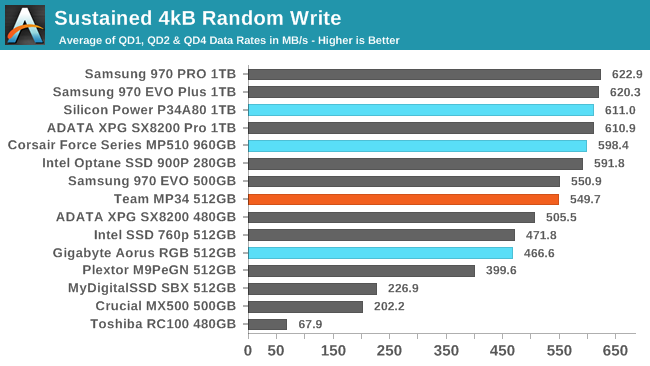
On the longer random write performance, the larger drives are unavoidably faster. But the new firmware in the Team MP34 brings its performance up to the level of the Samsung 970 EVO, a more significant increase than for the burst write speed.
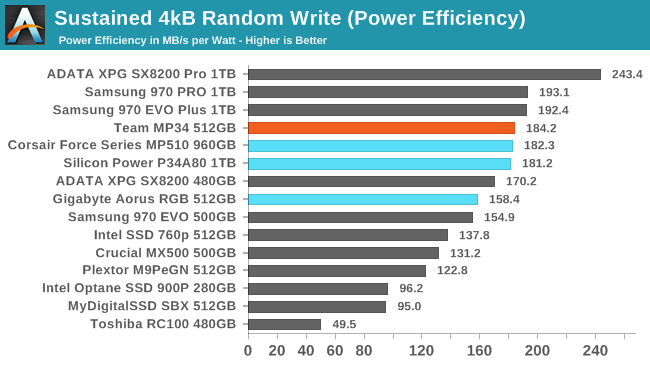 |
|||||||||
| Power Efficiency in MB/s/W | Average Power in W | ||||||||
The improved performance of the MP34 over the Gigabyte drive with older firmware brings power efficiency on the random write test up to the level of the faster 1TB drives. The MP34 draws very slightly more power than the Gigabyte Aorus despite the latter's RGB LEDs, but the MP34's extra power is well-spent.
 |
|||||||||
The Team MP34 is provides faster random writes than the Gigabyte Aorus RGB at all tested queue depths, and generally uses about the same power. Full performance is reached at QD4, which is typical for most drives.
The Team MP34's performance on the random write test is well above SATA territory but the modest capacity prevents it from reaching the high speeds that 1+TB drives hit. Power efficiency is decent, but there are a handful of drives that can write to their SLC caches at similar speeds with significantly lower power.


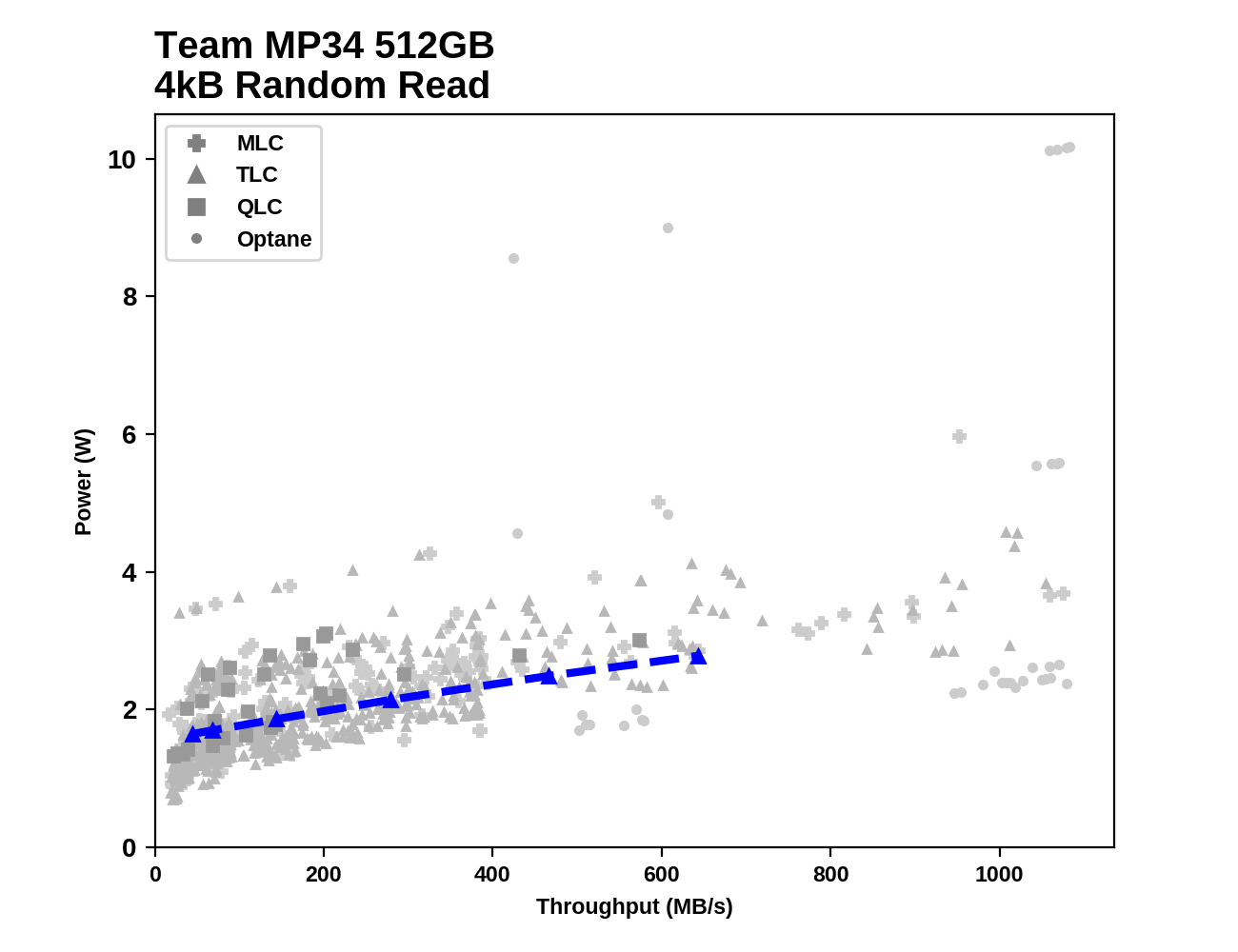
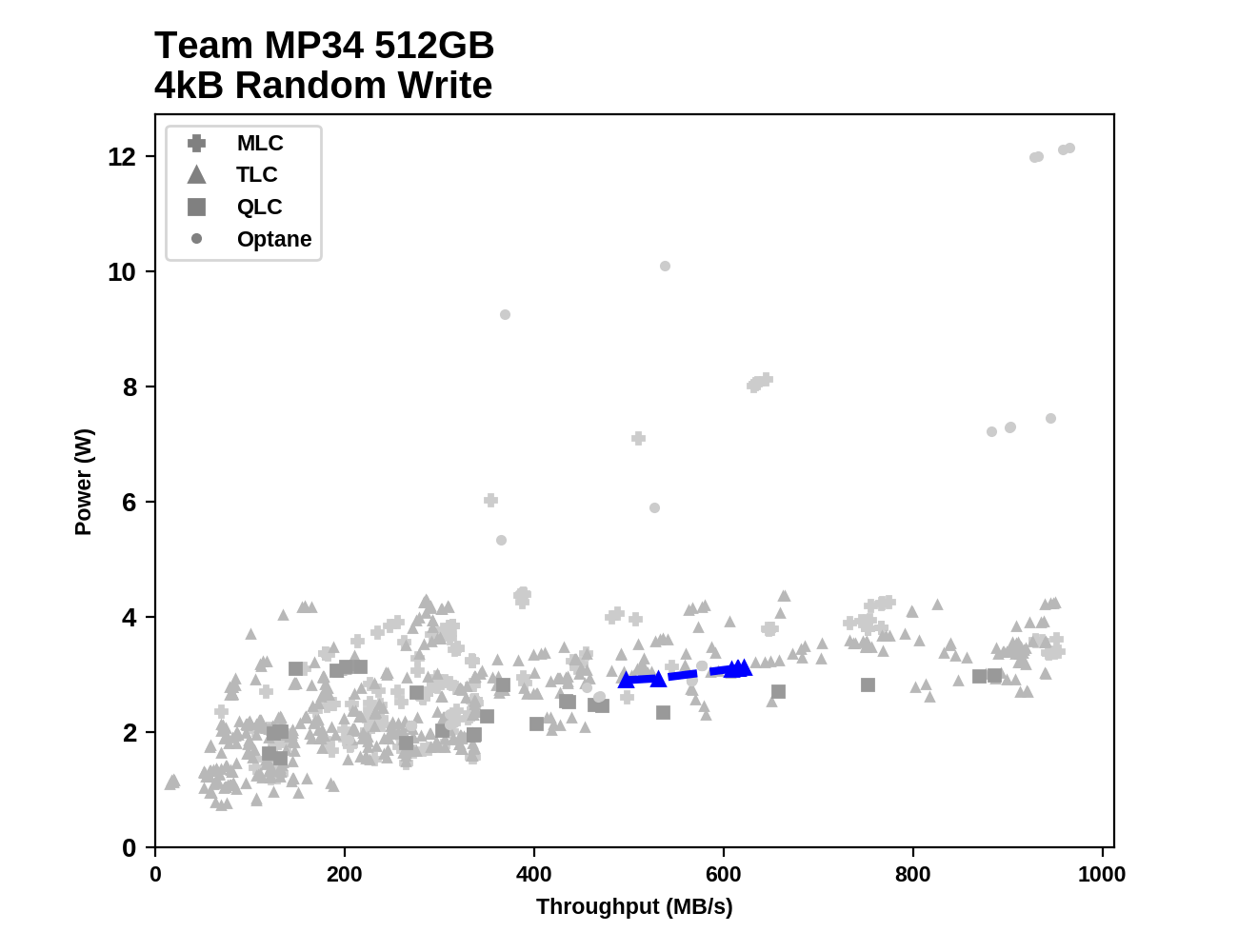








17 Comments
View All Comments
Samus - Wednesday, May 15, 2019 - link
Why is the WD Black missing from all the benchmarks - even the recently reviewed SN750 is missing?I’m at a loss here, you specifically mentioned it on the first page of the article, along with Samsung, yet included all the Samsung drives...
futrtrubl - Wednesday, May 15, 2019 - link
Last page. "..if we had the chance to test the 500GB WD Black SN750"kobblestown - Wednesday, May 15, 2019 - link
FWIW, I just bought a 480GB Corsair MP510 and the firmware is reported as ECFM12.2. I don't know if it's available for update of older devices though.ssd-user - Wednesday, May 15, 2019 - link
Can you _please_ sort the SSD's by worst-case ("disk full") numbers rather than best-case ones? I generally really like your reviews, but your sorting is simply wrong, and some horribly bad ssd's end up looking much better than they are because of it.Particularly for things like the 99% latency numbers it is inane to sort by the best case, since the whole point is about near-worst-case latencies, and bad controller should simply not be given the benefit of the doubt.
Note that unless you actually trim the ssd, even an empty filesystem will act like a full one, since the ssd doesn't know which parts are used. So as far as the ssd is concerned, it's all full. So the argument that "most people have lots of room on their disk" is quite likely bogus to begin with, but possibly entirely irrelevant even if it were to be true.
Death666Angel - Thursday, May 16, 2019 - link
They are storted by worst-case, just in reverse. And if you use an SSD without an automatic trim OS, it's kinda on you, isn't it?ssd-user - Thursday, May 16, 2019 - link
Death666Angel: please learn to read. They are *not* "sorted by worst-case, just in reverse".Look at the "ATSB - Heavy (99th Percentile Latency)" graph, just as an example.
In particular, look at the ADATA XPG SX8200 Pro 1TB one. Look at how absolutely *HORRIBLE* the latency is for that.
Yet the idiotic and incorrect sorting shows it as the second-best SSD on that list, because the *best-case* latency when the drive is empty is reasonable. But once it gets full, and $
Anybody who thinks that that drive should be second-best on that list is incompetent.
ssd-user - Thursday, May 16, 2019 - link
Fat-fingered the response. The "and $" should be "and garbage collection happens, latency becomes horrid".Death666Angel - Saturday, May 18, 2019 - link
I still stand by "If you have an OS that uses GC as a valid algorithm, you desever all the crap you brought upon yourself." But have fun being a blast at parties! Learn to read fricking diagrams and stop bitching. Or start being the change you wanna see in the world!leexgx - Saturday, May 18, 2019 - link
the issue is only with the dramless drives when they are above 60-70% full witch you should avoid (the sandisk/WD blue recant controller is cida dramless but it has 10mb of ram on the controller it self witch seems to be enough to mitigate the lack of a full blown dram)ssd-user - Sunday, May 19, 2019 - link
Exactly. The point is that you should avoid those drives.Which is why they shouldn't show up at the top of the charts. They are not top drives, they are the dregs, and they should show up as such.